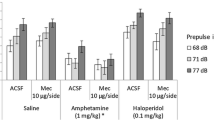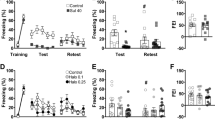Abstract
The classical conditioning of the behavioural effects of cocaine has been shown to contribute to behavioural sensitization. In the present experiments, it was demonstrated that the effects of cocaine in rats can be conditioned to contextual stimuli. Furthermore, sensitization to cocaine's locomotor effects were demonstrated, and shown to be context specific. Nimodipine (10 mg/kg, SC), an L-type dihydropyridine Ca2+ channel antagonist, appeared to completely block the establishment of conditioning of cocaine's effects, but only partially blocked sensitization to cocaine. Haloperidol (0.05 mg/kg, IP), a relatively specific D2 dopamine receptor antagonist, attenuated behavioral sensitization but had no influence on the establishment of the conditioned component of cocaine. These results indicate that the sensitization to, and the development of classical conditioning of, cocaine's behavioural effects can be pharmacologically dissociated, but that a non-associative process involved in sensitization is normally overridden by conditioning factors.
Similar content being viewed by others
References
Angrist B (1983) Psychoses induced by central nervous system stimulants and related drugs. In: Creese I (ed) Stimulants: neurochemical, behavioral, and clinical perspectives, Raven Press, New York, pp 1–30
Baldo BA, Kelley AE (1991) Cross sensitization between cocaine and GBR 12909, a dopamine uptake inhibitor. Brain Res Bull 27:105–108
Barr GA, Sharpless NS, Cooper S, Schiff SR, Paredes W, Bridger WH (1983) Classical conditioning, decay and extinction of cocaine-induced hyperactivity and stereotypy. Life Sci 33:1341–1351
Beninger RJ, Hahn BL (1983) Pimozide blocks establishment but not expression of amphetamine-produced environment-specific conditioning. Science 20:1304–1306
Beninger RJ, Herz RS (1986) Pimozide blocks establishment but not expression of cocaine-produced environment-specific conditioning. Life Sci 38:1425–1431
DiLullo SL, Martin-Iverson MT (1991) Presynaptic dopaminergic neurotransmission mediates amphetamine-induced unconditioned but not amphetamine-conditioned locomotion and defecation in the rat. Brain Res 568:45–54
DiLullo SL, Martin-Iverson MT (1992a) Evidence for presynaptic dopamine mechanisms underlying amphetamine-conditioned locomotion. Brain Res 578:161–167
DiLullo SL, Martin-Iverson MT (1992b) Calcium channel blockade: a potential adjunctive treatment with neuroleptics for stimulant abuse and schizophrenia. Biol Psychiatry 31:1143–1150
Kiess HO (1989) Statistical concepts for the behavioral sciences. Allyn and Bacon, Toronto
Martin-Iverson MT (1991) An animal model of stimulant psychoses. In: Boulton AA, Baker GB, Martin-Iverson MT (eds) Neuromethods, vol 18. Animal models in psychiatry I. Humana Press, Clifton, NJ, pp 103–149
Martin-Iverson MT, McManus DJ (1990) Stimulant-conditioned locomotion is not affected by blockade of D1 and/or D2 dopamine receptors during conditioning. Brain Res 521:175–184
Martin-Iverson MT, Yamada N (1992) Synergistic behavioural effects of dopamine D1 and D2 receptor agonists are determined by circadian rhythms. Eur J Pharmacol 215:119–125
Martin-Iverson MT, Stahl SM, Iversen SD (1987) Factors determining the behavioral consequences of continuous treatment with 4-propyl-9-hydroxynaphthoxazine, a selective dopamine D2 agonist. In: Clifford F (ed) Parkinson's disease: clinical and experimental advances. John Libbey, London, pp 169–177
Martin-Iverson MT, Iversen, SD, Stahl SM (1988a) Long-term motor stimulant effects of (+)-4-propyl-9-hydroxynaphthoxazine (PHNO), a dopamine D-2 receptor agonist: interactions with a dopamine D-1 receptor antagonist and agonist. Eur J Pharmacol 149:25–31
Martin-Iverson MT, Stahl SM, Iversen SD (1988b) Chronic administration of a selective dopamine D-2 agonist: factors determining behavioral tolerance and sensitization. Psychopharmacology 95:534–539
Mattingly BA, Gotsick JE (1989) Conditioning and experiential factors affecting the development of sensitization to apomorphine. Behav Neurosci 103:1311–1317
Mattingly BA, Rowlett JK (1989) Effects of repeated apomorphine and haloperidol treatments on subsequent behavioral sensitivity to apomorphine. Pharmacol Biochem Behav 34:345–347
Muntaner C, Cascella NG, Kumor KM, Nagoshi C, Herning R, Jaffe J (1989) Placebo responses to cocaine administration in humans: effects of prior administrations and verbal instructions. Psychopharmacology 99:282–286
Nielsen EB (1981) Rapid decline of stereotyped behavior in rats during constant one week administration of amphetamine via implanted ALZET osmotic minipumps. Pharmacol Biochem Behav 15:161–165
O'Brien CP, Ehrman R, Ternes J (1986) Classical conditioning in human opioid dependence. In: Goldberg SG, Stolerman IP (eds) Behavioral analysis of drug dependence. Academic Press, Orlando, FL, pp 329–356
O'Brien CP, Childress AR, Arndt IO, McLennan AT, Woody GE, Maany I (1988) Pharmacological and behavioral treatments of cocaine dependence: controlled studies. J Clin Psychiatry 49:17–22
Pani L, Kuzmin A, Diana M, De Montis G, Gessa GL, Rossetti Z (1991a) Dihydropyridine calcium antagonists prevent cocaine-induced dopamine release and motor activity in rats. Posters Neurosci 1:85–88
Pani L, Kuzmin A, Martellotta MC, Gessa GL, Fratta W (1991b) The calcium channel antagonist PN 200-110 inhibits the reinforcing properties of cocaine. Brain Res Bull 26:445–447
Post RM, Lockfeld A, Squillace KM, Contel NR (1981) Drug-environment interaction: context dependency of cocaine-induced behavioral sensitization. Life Sci 28:755–760
Robinson TE, Becker JB (1986) Enduring changes in brain and behavior produced by chronic amphetamine administration. Brain Res Rev 11:157–198
Schiff SR (1982) Conditioned dopaminergic activity Biol Psychiat 17:135–155
Stewart J, Vezina P (1991) Extinction procedures abolish conditioned stimulus control but spare sensitized responding to amphetamine. Behav Pharmacol 2:65–71
Trouve R, Nahas G (1986) Nitrendipine: an antidote to cardiac and lethal toxicity of cocaine. Proc Soc Biol Med 183:392–397
Vitaliano PP (1982) Parametric statistical analysis of repeated measures experiments. Psychoneuroendocrinology 7:3–13
Weiss SR, Post RM, Pert A, Woodward R, Murman D (1989) Context-dependent cocaine sensitization: differential effect of haloperidol on development versus expression. Pharmacol Biochem Behav 34:655–661
Author information
Authors and Affiliations
Rights and permissions
About this article
Cite this article
Reimer, A.R., Martin-Iverson, M.T. Nimodipine and haloperidol attenuate behavioural sensitization to cocaine but only nimodipine blocks the establishment of conditioned locomotion induced by cocaine. Psychopharmacology 113, 404–410 (1994). https://doi.org/10.1007/BF02245216
Received:
Revised:
Issue Date:
DOI: https://doi.org/10.1007/BF02245216




